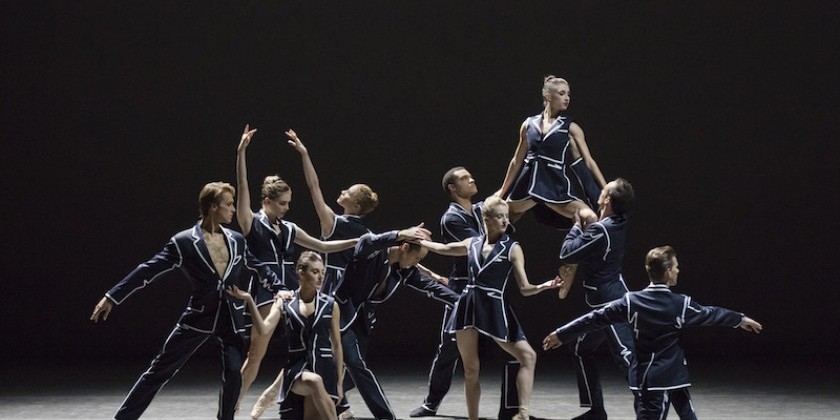IMPRESSIONS: Foofwa d'Imobilite'/Neopost Ahrrt

Foofwa d'Imobilite' at Dance New Amsterdam January 24, 2010
Musings re Merce John and Bob (US Premiere) and Involuntaries 1-6 (World Premiere)
Credits as they appear in the program:
For Musings
Theatrical meditations by: Foofwa d’Imobilite in homage to Merce Cunningham
Possibly give the title Cage A Cappella to the music and Rauschenberg’s skin to the costume
Solitary duet interpreted by Foofwa dit Mobilite
Luminous project by Jonathon O’Hear (thanks to Florian Bach)
Administrative experimentations orchestrated by Yann Aubert and accounted for by
Corine Magenate
For Involuntaries
A collaboration with Foofwa d’Imobilite, Alan Sondheim, and Azure Carter
Costumes by Basse- Coutre
Credits as they appear in the program:
For Musings
Theatrical meditations by: Foofwa d’Imobilite in homage to Merce Cunningham
Possibly give the title Cage A Cappella to the music and Rauschenberg’s skin to the costume
Solitary duet interpreted by Foofwa dit Mobilite
Luminous project by Jonathon O’Hear (thanks to Florian Bach)
Administrative experimentations orchestrated by Yann Aubert and accounted for by
Corine Magenate
For Involuntaries
A collaboration with Foofwa d’Imobilite, Alan Sondheim, and Azure Carter
Costumes by Basse- Coutre
©Christine Jowers 2010
Musings on Musings…
Somewhere, perhaps in the copious program notes provided by choreographer/performer Foofwa d’Imobilite', the artist formerly known as Frederic Gafner, a member of the Merce Cunningham Dance Company from 1991 -1998, we learn that his striking painted -on -skin outfit is to resemble a signature Merce Cunningham unitard. Also, it is meant to echo the bold colored strokes of a Robert Rauschenberg painting. (Effective on both counts.) But, the brilliant red, yellows, blues and greens, the arrows drawn on the side of one leg, the industrially taped pictures of Merce Cunningham, and –is it John Cage or Robert Rauschenberg -- on his body, could also be tribal markings--the colors and signs of a dancer wearing the philosophies of his ancestors.
As members of the dance tribe, we move with our ancestors constantly, whether we acknowledge it or not. Their gestures, words, desires and aesthetics are part our personal geography. D’Imobilite' recalls his lineage and connection to the perspective-shifting Cunningham, Rauschenberg and Cage in his captivating solo work.
Musings begins with a spritely duet between man and air, finding d’Imobilite' continually extending his right hand to meet, courtly greet, and whimsically take a turn on the floor with an invisible waltzing partner. Suddenly she, or he, vanishes –and blackout. We are left in the dark now, and also in between each of the following sections of this piece. These silent spaces allow for contemplation. I like them. The pauses give us an opportunity to remember that this work is about people who are no longer with us. They also give us time to acknowledge that this art is fleeting—disappearing suddenly with the flick of a switch.
Jonathon O’Hear's lighting proves an engaging partner for d’Imobilite'. It often shifts our focus away from the soloist and onto the space. What is really important? Is it the dancer and what he is doing, or what he is looking at, or the space around him? One aspect of Cunningham’s work that radically set him apart from his dance ancestors was that he assigned no particular hierarchy to dance or space.
The lighting creates distinct spatial atmospheres, as in one of my favorite moments when bulbs flicker and shudder as d’Imobilite, staggering, falls into unsteady, but then certain birdlike balance. As the lighting creates tunnels and caverns for him to fall through, he blows about on a precarious journey, an explorer of unfamiliar territory. For me it conjured up images of Cunningham in his latter days, tribal elder and explorer extraordinaire, performing with a shaky nimbleness on stage.
d’Imobilite' fully fills his choreography with signatory Cunningham elements-- simple, expansive, upper body tilts and contractions --without the Martha Graham drama. Bright accented foot gestures that brush and lift off the floor eventually moving through the space and evolving into more technically virtuosic asymmetrical leaning pirouettes and explosive jumps.
As d’Imobilite' progresses through his work with grace and precision, he accompanies himself with vocal sounds: clips, and blips, hums and sometimes words. He sings about “a boy named Mercier who, in dance and theater, pushed things all the way.” In his moments of stillness I am reminded of photographs of Cunningham –poses where he is set, ready to dart, like a bird or lizard.
In the last section of the dance, our soloist alternates between speaking in the voice of John Cage about music and dance being everywhere, like the weather, and speaking as Cunningham who, while dancing and talking, continues to look at his watch --you can almost here him saying, “ I‘ve done enough of that bit - now onto the next section.”
With consideration, expertise, fancy and a bit of grease paint, the younger tribesman conjures up his ancestors.
Involuntaries 1-6 stars d’Imobilite, Alan Sondheim, and Azure Carter in a collaboration of spastic noisy fits courtesy of d’Imobilite, furious string instrument playing courtesy of Sondheim, and moaning song courtesy of Carter. I wasn’t clear where the collaboration came in, as each artist seemed deeply engaged-vigorously, loudly, and incessantly in their own activity ignoring each other and effectively shutting out the audience. I am a patient woman and an enthusiast, but I look for dance as a way into an experience. I am confused when obviously talented intelligent people make me want to run away from their work. Or was that the point? If so-- not my cup of tea.



















